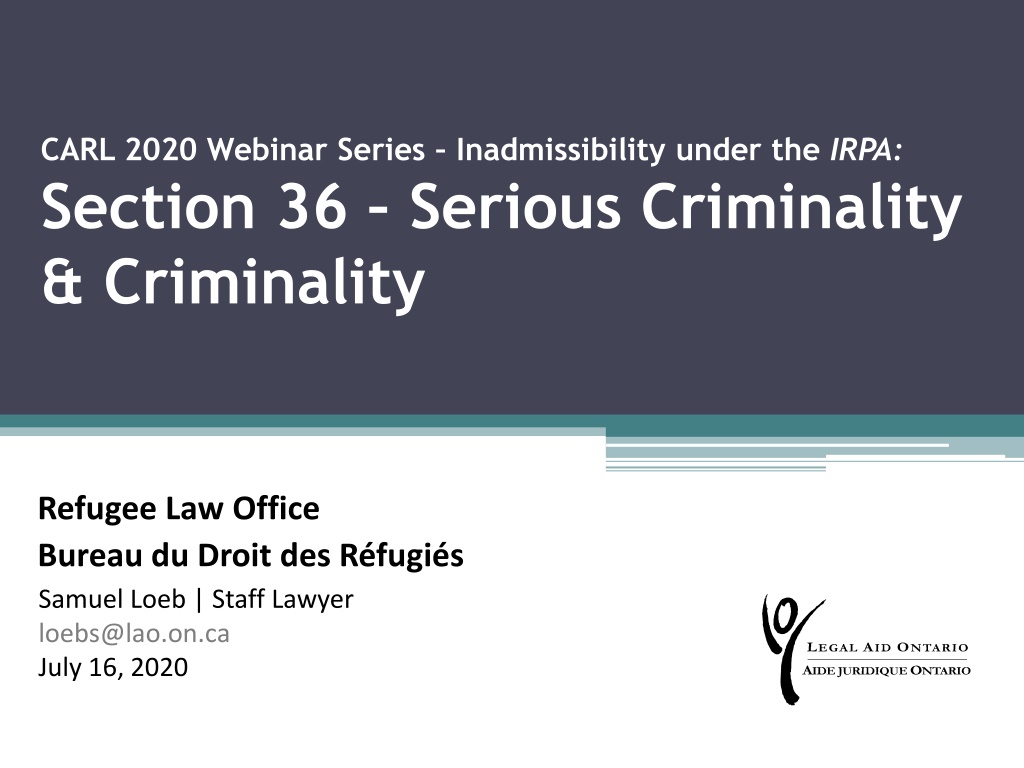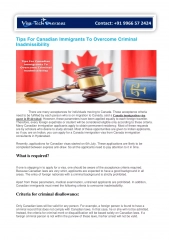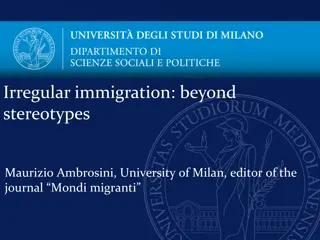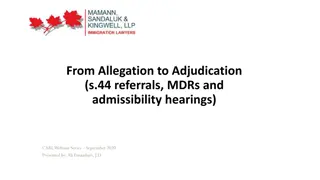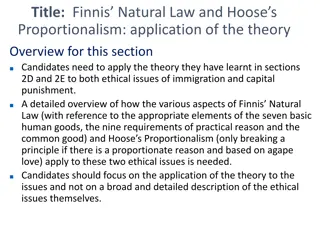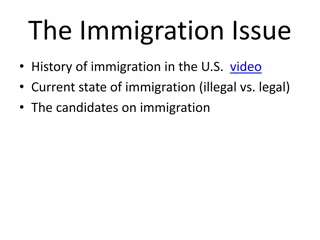Understanding Inadmissibility under Canadian Immigration Law
Explore the complexities of inadmissibility under Canadian immigration law, focusing on sections 36(1) and 36(2) of the Immigration and Refugee Protection Act (IRPA). Learn about serious criminality criteria, in-Canada convictions, criminality definitions, and the inadmissibility process. Discover how reports are prepared, potential outcomes, and the significance of criminal dispositions for non-citizens in Canada.
Download Presentation

Please find below an Image/Link to download the presentation.
The content on the website is provided AS IS for your information and personal use only. It may not be sold, licensed, or shared on other websites without obtaining consent from the author. Download presentation by click this link. If you encounter any issues during the download, it is possible that the publisher has removed the file from their server.
E N D
Presentation Transcript
CARL 2020 Webinar Series Inadmissibility under the IRPA: Section 36 Serious Criminality & Criminality Refugee Law Office Bureau du Droit des R fugi s Samuel Loeb | Staff Lawyer loebs@lao.on.ca July 16, 2020
Immigration consequences for non-Canadian citizens: Canada (Minister of Employment and Immigration) v. Chiarelli, [1992] 1 SCR 711: The most fundamental principle of immigration law is that non citizens do not have an unqualified right to enter or remain in the country. To understand the immigration consequence of criminal dispositions and sentences for non- citizens, it is essential to learn the definition of three terms-of-law under the IRPA: Serious criminality (s.36(1) of IRPA) S. 36(1)(a): in-Canada convictions S. 36(1)(b), (c): out-of-Canada convictions and criminals acts/offences Criminality (s.36(2)) S. 36(2)(a): in-Canada convictions S. 36(2)(b), (c): out-of-Canada convictions and criminal acts/offences S. 36(2)(d): offences upon entry to Canada Organized criminality (s.37) will be covered in the July 30, 2020 CARL webinar with Erica Olmstead
How is the s. 36(1)/(2) inadmissibility process initiated? An officer prepares a s. 44(1) Report: S 44. (1) An officer who is of the opinion that a permanent resident or a foreign national who is in Canada is inadmissible may prepare a report setting out the relevant facts, which report shall be transmitted to the Minister. The Minister may refer the Report for an admissibility hearing or, in the case of a foreign national, may make a removal order: (2) If the Minister is of the opinion that the report is well-founded, the Minister may refer the report to the Immigration Division for an admissibility hearing, except in the case of a permanent resident who is inadmissible solely on the grounds that they have failed to comply with the residency obligation under section 28 and except, in the circumstances prescribed by the regulations, in the case of a foreign national. In those cases, the Minister may make a removal order.
Serious criminality under IRPA for in- Canada convictions(s.36(1)(a)): Serious criminality in Canada refers to a permanent resident or a foreign national who has been convicted in Canada of any offence under an Act of Parliament (i) punishable by a maximum term of imprisonment of at least 10 years OR (ii) for which a term of imprisonment of more than six months has actually been imposed. S. 2 of IRPA: foreign national means a person who is not a Canadian citizen or a permanent resident, and includes a stateless person . S. 36(1) therefore also includes protected persons.
Criminality under IRPA for in-Canada convictions (s.36(2)): Criminality in Canada refers to a foreign national (not a permanent resident) who has been convicted in Canada (i) of an offence under an Act of Parliament punishable by way of indictment, OR (ii) of two offences under any Act of Parliament not arising out of a single occurrence All hybrid offences are deemed indictable regardless of how the Crown elects to proceed (IRPA, s.36(3)(a)) thus only first-time conviction for a pure summary offence will not render a foreign national inadmissible for criminality.
What dispositions do not amount to criminality under IRPA? Criminal charges that result in a disposition short of a conviction such as stays, discharges, peace bonds, NCR do not result in criminal inadmissibility under s.36 of the IRPA. Criminality does not result in an offence for which a person is found guilty under the Young Offenders Act (s.36(3)(e)) for which a person received a youth sentence under the Youth Criminal Justice Act (s.36(3)(e)) record suspension has been granted (s.36(3)(b)) designated as a contravention under the Contraventions Act (s.36(3)(e))
What needs to be established? The person concerned is not a Canadian citizen (as it concerns s. 36(1)(a)) and/or not a Canadian permanent resident (as it concerns s. 36(2)(a)). The person concerned was convicted of an offence described in s. 36(1)(a)/36(2)(a). If the Immigration Division is satisfied of those two elements, they will find the person concerned inadmissible for criminality/serious criminality and issue them a removal order. The Immigration Division does not have any jurisdiction to consider humanitarian and compassionate factors.
What can you do? Not much, if the alleged facts are correct. But CBSA gets it wrong! Make sure to satisfy yourself RE: those two elements: Does the person concerned have access to Canadian citizenship (i.e. born abroad to a Canadian citizen, adopted as a minor by a Canadian citizen?)? Ensure CBSA provides, at a minimum, the Court information and not just a statutory declaration, which may contain errors. Confirm: Was the person concerned convicted? Is the offence they re convicted of described in s. 36(1)(a)/36(2)(a)? Appeal the conviction or sentence itself.
Withdrawing a guilty plea based on unknown collateral immigration consequences: R v. Wong, 2018 SCC 25: [4] [F]or a plea to be informed, an accused must be aware of the criminal consequences of the plea as well as the legally relevant collateral consequences. A legally relevant collateral consequence is one which bears on sufficiently serious legal interests of the accused. Here, Mr. Wong was not aware of the immigration consequences of his conviction and sentence. Immigration consequences bear on sufficiently serious legal interests to constitute legally relevant consequences. His guilty plea was therefore uninformed. What degree of knowledge of immigration consequences does an accused need to have to render her plea voluntary? Do they have to know the specific immigration consequences or just that some adverse immigration consequences could follow. See: R. v. Shiwprashad, 2015 ONCA 577 at para. How remote do the immigration consequences have to be before they stop being legally relevant? See: R. v. Pavao, 2018 ONSC 4889, para. 84 but see also Cha v. Canada (MCI), 2006 FCA 126, para. 35
Sentence appeals based on unknown collateral immigration consequences: R v. Pham, 2013 SCC 15: [24] An appellate court has the authority to intervene if the sentencing judge was not aware of the collateral immigration consequences of the sentence for the offender, or if counsel had failed to advise the judge on this issue. In such circumstances, the court s intervention is justified because the sentencing judge decided on the fitness of the sentence without considering a relevant factor: M. (C.A.), at para. 90. adjustments to sentences to avoid immigration sentences (i) will usually be modest; (ii) cannot render an unfit sentence into a fit one; and (iii) cannot result in a de facto separate sentencing range for non-citizens
Calculating sentences under IRPA (1): For convictions captured by the first clause of s.36(1)(a) ( having been convicted in Canada of an offence under an Act of Parliament punishable by a maximum term of imprisonment of at least 10 years ), the actual sentence imposed is irrelevant. Rather, an individual is inadmissible if they are convicted of an offence that has a maximum term of imprisonment of at least ten years even if the person received no jail time. The maximum sentence under the first prong of s.36(1) is assessed as that available on the date of the commission of the offence: Tran v. Canada (MPSEP), 2017 SCC 50
Calculating sentences under IRPA (2): Under the IRPA, the calculation of the length of a sentence of imprisonment imposed includespre-trial/ pre-sentence custody and it is irrelevant if and how early the offender is paroled. As stated by the Federal Court of Appeal in Martin 2005 FCA 347: [W]e are all of the view that the word punished in subsection 64(2) of the Immigration and Refugee Protection Actrefers to the sentence imposed, not the actual duration of incarceration. The same principle applies under s.36(1) of the IRPA. See also: Brown, 2009 FC 660; Atwal, 2004 FC 7.
Calculating sentences under IRPA (3): Where a sentencing judge is silent on the ratio applied to Pre-Trial Custody (PTC), it is presumed to be 1:1 time: Brown and Livermore v. MPSEP [2007] I.A.D.D. No. 2411, No. TA2-25093. See also: Jamil, [2005] F.C.J. No. 955. Where PTC is already over 6 months, a Judge intending to avoid immigration consequence should explicitly indicate on the record that this dead time is not forming part of the sentence.
Calculating sentences under IRPA (4): Immigration authorities consider the length of sentence that each individual conviction attracted. Where large global sentence is imposed for multiple convictions, the Judge can avoid triggering some immigration consequences by dividing it up into individual sentences of less than 6 months: R v. Dhindsa, 2018 BCPC 33. But to do this, a sentence of less than 6 months must be a fit sentence for each conviction and not an artificial apportioning of sentences to avoid Parliament s intent concerning serious crimes: R. v. Duncan, 2018 ONCA 574; R. v. Pavao, 2018 ONSC 4889, R v. Lal, Mohammed and Mohammed, 2016 ONCA 678.
Calculating sentences under IRPA (5): A conditional sentence is not a term of imprisonment for immigration purposes and so its length triggers no immigration consequences: Tran v. Canada (MPSEP), 2017 SCC 50 at para.25: the seriousness of criminality punished by a certain length of jail sentence is not the same as the seriousness of criminality punished by an equally long conditional sentence. In other words, length of the sentence alone is not an accurate yardstick with which to measure the seriousness of the criminality of the permanent resident.
Serious criminality for out-of-Canada convictions(s.36(1)(b)) and criminal acts (s. 36(1)(c)): 36(1) A permanent resident or a foreign national who has: (b) been convicted of an offence outside of Canada that, if committed in Canada, would constitute an offence punishable by a maximum term of imprisonment of at least 10 years; (c) committed an act outside of Canada that is an offence in the place where it was committed AND, if committed in Canada, would constitute an offence punishable by a maximum term of 10 years
Criminality for out-of-Canada convictions(s.36(2)(b)) and criminal acts (s. 36(2)(c)): 36(2) A foreign national who has: (b) been convicted of an offence outside of Canada that, if committed in Canada, would constitute an indictable offence OR of two offences not arising out of a single occurrence that, if committed in Canada, would constitute offences; (c) committed an act outside of Canada that is an offence in the place where it was committed AND, if committed in Canada, would constitute an indictable offence (d) committing, on entering Canada, an offence under an Act of Parliament prescribed by Regulations
The elements of s. 36(1)(b)/36(2)(b) inadmissibility Must conduct an equivalency assessment, as set out by the FCA in Hill v. Canada (MEI) (1987), 73 NR 315. Equivalency can be established in one of three ways: (1) by comparing the precise wording in each statute both through documents and, if available, through the evidence of experts in the foreign law in order to determine the essential elements of the respective offences; (2) by examining the evidence, both oral and documentary, to ascertain whether that evidence is sufficient to establish that the essential elements of the offence in Canada had been proven in the foreign proceedings, whether precisely described in the initiating documents or in the statutory provision in the same words or not; (3) a combination of the two.
The elements of s. 36(1)(b)/36(2)(b) inadmissibility The FCA elaborated on the equivalency process in Li v. Canada (MCI), [1996] FCJ 1060 (FCA): The key assessment is comparing the essential elements of the respective offences, which requires a comparison of the definition of those offences, including defences. However, it is not necessary to conduct a retrial of the case applying Canadian rules of evidence or an examination of the validity of the foreign conviction. What is being examined is the comparability of offences, not the comparability of possible convictions in the two countries.
The elements of s. 36(1)(c)/36(2)(c) inadmissibility The same equivalency assessment from 1(b) and 2(b) and demonstrating that the person concerned committed the offence, notwithstanding the lack of Most of the jurisprudence of 1(c) and 2(c)still focusses on the equivalency assessment, rather than whether there s sufficient evidence that the person concerned committed the offence. This seems to stem from the relatively modest reasonable grounds to believe standard. See, for example, Singh v. Canada (MCI), 2019 FC 946 at para. 23. Charges not proved beyond a reasonable doubt can be used to establish the necessary elements. Solmaz v. Canada (MCI), 2019 FC 736 at para. 23. There can be a finding of inadmissibility, notwithstanding an acquittal. Magtibay v. Canada (MCI), 2005 FC 397 at para. 12: person concerned was acquitted due to a defence that doesn t exist in Canadian law.
The elements of s. 36(1)(c)/36(2)(c) inadmissibility In Urdas v. Canada (MCI), 2019 FC 131, the Chief Justice found the reasonable belief that the person concerned may well have participated in a stabbing was sufficient. There, a charge was laid, then withdrawn. In Red v. Canada (MCI), 2018 FC 1271, the Court found the officer had failed to explain in sufficient detail that an offence was committed, in light of clear evidence that the charge in question had been withdrawn after the complainant acknowledged its understandings of the facts had been incorrect and prosecution could not be successful. Note that, per s. 36(3)(d), if the person concerned is a permanent resident, an inadmissibility determination under s. 36(1)(c) must be based on a balance of probabilities.
The elements of s. 36(2)(d) inadmissibility Committing, on entering Canada, an offence under an Act of Parliament prescribed by the Regulations S. 19 of the Regulations sets out the prescribed class: indictable offences under the Criminal Code, IRPA, Firearms Act, Customs Act, Controlled Drugs and Substances Act and the Cannabis Act. This provision also does not require a conviction. Very little FC jurisprudence: Relied on forged letter from a college to try to gain entry into Canada. The ID found him inadmissible for committing the offence of uttering a forged document. Wang v. Canada (MCI), 2006 FC 625 Student caught returning to Canada with 0.001g of cannabis residue in his luggage and a small bag with 0.5 g of cannabis. The evidence demonstrated the marijuana was prescribed to help treat his epilepsy and he had brought it inadvertently. The police didn t lay charges but CBSA argued he had breached s. 159 of the Customs Act (smuggling a prohibited good). The ID found him inadmissible under s. 36(2)(d), but the FC granted judicial review because it found the ID erred in its interpretation of s. 159. Linise v. Canada (MCI), 2012 FC 1166.
36(3)(b) - pardons 36(3)(b) 36(1) and (2) inadmissibility may not be based on a conviction for which a record suspension has been ordered under the Criminal Records Act or there has been a final determination of an acquittal. 36(3)(b) can apply to foreign pardons, though they are not explicitly mentioned in the statute. There is no absolute right to having a foreign pardon considered as a Canadian pardon. We must consider the effect of the foreign pardon to determine whether it should be treated as a Canadian record suspension, based on the criteria laid out in Canada (MCI) v. Saini, 2001 FCA 311: (1) the foreign legal system as a whole must be similar to that of Canada; (2) the aim, content and effect of the specific foreign law must be similar to Canadian law; and (3) there must not be a valid reason not to recognize the effect of the foreign law.
36(3)(c) rehabilitation Applies only to convictions/acts abroad (36(1)(b)/(c) and 36 (2)(b)/(c)) No inadmissibility if the permanent resident or foreign national who, after the prescribed period: Satisfies the Minister they ve been rehabilitated; OR Is a member of a prescribed class deemed to be rehabilitated Prescribed period is set out in s. 17 of the Regulations: five years after: RE: s. 36(1)(b) and (2)(b) - completion of the sentence, if no subsequent offences RE: s. 36(1)(c) and (2)(c) committing the offence, if no subsequent convictions Deemed rehabilitated class is set out in s. 18 of the Regulations, includes various factors, including length of time since completing the sentence, no re-offending etc.
36(3)(c) rehabilitation Sun v. Canada (MCI), 2011 FC 708 [12] If one provides sufficient evidence that one meets the criteria set out in section 18 of the Regulations for the class of persons deemed to have been rehabilitated , the officer reviewing the visa application must consider the person rehabilitated and evaluate the application on its merits. [13] If one does not fall within a deemed class, one must provide evidence that one has obtained a ministerial decision that the person is rehabilitated. There is no right to such rehabilitation (distinct from deemed rehabilitation). One must apply for it and satisfy the Minister or his delegate that one has been rehabilitated. A person can make such an application five years after the completion of an imposed sentence (for matters referred to in paragraphs 36(1)(b) and (2)(b) of IRPA) or five years after committing an offence (for matters referred to in paragraphs 36(1)(c) and (2)(c) of IRPA), as is prescribed by section 17 of the Regulations.
36(3)(e) Youth offences & Contravention Act applies to s. 36(1) and (2) (e)(i) no inadmissibility for an offence designated as a contravention under the Contravention Act (e)(ii) no inadmissibility for guilty findings under the Young Offenders Act (e)(iii) no inadmissibility for youth sentences under the Youth Criminal Justice Act Deemed rehabilitated class is set out in s. 18 of the Regulations, includes various factors, including length of time since completing the sentence, no re-offending etc.
36(3)(e) Youth offences & Contravention Act M Bosso v. Canada (MCI) 2011 FC 302 [14] The YCJA now includes the concepts of youth sentence ( peine sp cifique ) and adult sentence ( peine applicable aux adultes ). In accordance with the guiding principle of the YOA, the YCJA favours youth sentences for young people. Section 72 of the YCJA states that it is only when a youth sentence would not be of sufficient length to hold the young person accountable for his or her offending behaviour that the youth justice court will order that an adult sentence be imposed. The court must still today consider the age, maturity, character, background and previous record of the young person and any other factors that the court considers relevant. [15] Only an adult sentence imposed by a youth justice court under the YCJA or a conviction and sentence imposed by an adult court at the time of the YOA will have consequences in terms of immigration.
36(3)(e) What about youth offences committed abroad? 36(3)(e) is silent on offences committed abroad as a youth, just as (b) is silent on foreign pardons. Is it limited to offences under the YOA and YCJA, or does it extend to foreign youth offending and sentencing regimes, the way Saini allows for for foreign pardons? If the explicit and exclusive reference to the CRA in s. 36(3)(b) does not bar consideration of foreign pardons, then arguably, the explicit and exclusive references to the YOA and YCJA in s. 36(3)(e) should not bar consideration of the age of young offenders convicted of foreign offenses.
Consequences of criminality finding: Foreign national: Criminality (inside and outside Canada): Deportation order with no right of appeal Serious Crim (inside and outside Canada): Deportation with no right of appeal Permanent Resident or Protected Person (non-Canadian Citizen): Criminality (inside and outside Canada):No consequences Serious Crim (inside Canada): Deportation order with right of appeal if the sentence, including any credit for time served, is less than six months. Serious Crim (outside Canada): Deportation order with no right of appeal
Consequences of criminality finding: S. 36(1): inadmissible if convicted of an offence punishable by a maximum term of at least 10 years or term of imprisonment of more than six months imposed. S. 64(2): No right of appeal to the IAD if reportable offence punished by a term of imprisonment of at least six months. Same sentence, different consequences: A permanent resident convicted of simple assault (s. 266 of the Criminal Code - maximum sentence of five years) and sentenced to a term of imprisonment of six months will have no inadmissibility consequences A permanent resident convicted of assault with a weapon (s. 267 of the Criminal Code maximum sentence of 10 years) and sentenced to a term of imprisonment of six months will be inadmissible to Canada for serious criminality with no right of appeal to the IAD
If no right of appeal to the IAD: If the person concerned has no right of appeal to the IAD, they must apply for leave and judicial review to challenge a s. 36 inadmissibility decision (s. 72(2)(a) IRPA). If applying to judicially review a s. 44(1) Report and/or s. 44(2) referral, it is advisable to also apply to judicially review the inadmissibility decision itself. This will avoid concerns of a collateral attack on the inadmissibility decision. Huang v. Canada (MCI), 2015 FC 28 at para. 80. Though, see also, Clare v. Canada (MCI), 2016 FC 545at para. 10. The Court appears to be open to an applicant applying for leave and judicial review of the s. 44 decisions and the inadmissibility decision of the Immigration Division all within the same application for leave. Chambers v. Canada (MCI), 2016 FC 1407 at paras. 2-3, Clare v. Canada (MCI), 2016 FC 545at paras. 9-10. If the Court quashes either or both of the s. 44(1) Report and s. 44(2) referral, the ultimate inadmissibility decision should not stand. Hernandez v. Canada (MCI), 2005 FC 429 at para. 5, Abdul v. Canada (MPSEP), 2019 FC 154 at para. 3, 24
Right of appeal to the IAD: Right of appeal to the Immigration Appeal Division ( IAD ): S. 63(3): Permanent Residents and Protected Personshave a right to appeal a serious criminality finding to the IAD in what is known as a Removal Order Appeal . The IAD may make a decision to temporarily stop their deportation and put them on an immigration stay with conditions instead the equivalent of immigration probation if humanitarian and compassionate grounds warrant it. At the end of the stay period, based on their compliance with the conditions, the IAD will decide whether to quash the deportation order OR whether to extend the stay OR whether to dismiss the appeal and allow the permanent resident to be deported. There is no right of appeal for serious criminality that relates to a conviction for which a sentence of 6 months or more imprisonment (excluding a conditional sentence) has been imposed: s.64(2) of IRPA.
Permanent residents on IAD stays: Almost all IAD stays require the person not to accrue any further criminal convictions. If a permanent resident is convicted of criminalityoffence, the Minister can request that their IAD stay be cancelled or the IAD can dismiss their immigration appeal when the stay expires. If an individual is granted an IAD stay but is then convicted of another serious criminality offence before it expires, their appeal is immediately terminated by operation of law and they are deportable with no further right of appeal: s.68(4) of IRPA.
Other consequences of criminality (1): Ineligible to make a refugee claim -s.101(f) of IRPA A foreign national found inadmissible for serious criminality is ineligible to have their claim for refugee protection heard. However, this only applies if the offence carried a maximum sentence of 10+ years. Loss of protection from deportation to moratorium countries -s.230 of IRPR Foreign nationals inadmissible for any kind of criminality serious criminality or for criminality are not able to benefit from this moratorium.
Other consequences of criminality(2): Application for Canadian Citizenship- Delayed or Voided: A permanent resident cannot apply for citizenship if they have been convicted an indictable offence in the past four years (calculated from the completion of complete sentence, including parole, probation order and fine payment): s.22 of Citizenship Act. A conviction for an indictable offence will also void a pending citizenship application. Time spent serving a sentence, under a probation order or on parole cannot count towards the citizenship period of residence :1095 days (3 years) in last 5 years prior to citizenship app. [s. 21 of Citizenship Act] . Cannot receive Canadian citizenship while charged with, on trial for, or appealing an indictable offence. Note: Unlike under IRPA, an indictable offence under the Citizenship Act includes only straight indictable offences and hybrid offences where the Crown elected to proceed by indictment.
Questions Samuel Loeb, Staff Lawyer, Refugee Law Office loebs@lao.on.ca
